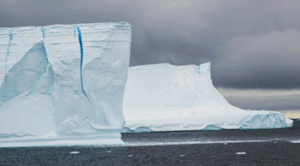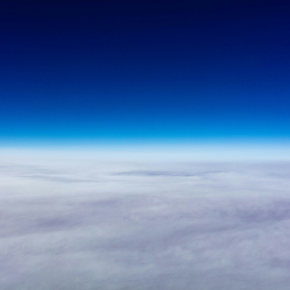OISO, observing the Indian Ocean
Observing the ocean in its greatest details is a fundamental step to understand the functioning of climate systems and its variations. OISO (Océan Indien Service d’Observations) is a National Observation Service (SNO) which collects data in the Southern Ocean and Southern Indian Ocean for over 20 years, following the evolution of the carbon pump and acidification. These regions are still under-documented despite their key role in the exchanges of carbon between the atmosphere and the ocean.
Aboard the Marion Dufresne, French supply ship for the French Southern and Antarctic Territories, scientific expeditions take turns to collect samples of the ocean. A pump under the boat hull draws water continuously and sends it to the OISO laboratory on board. From there are analysed the water salinity and the parameters of oceanic CO2 (fugacity, quantity of dissolved inorganic carbon, alkalinity) giving information on the exchanges between the air and the surface of the sea. But some measures, such as nutritive elements, require manual sampling that are done every 4 to 8 hours. The ship’s path is also dotted by fixed stations that researchers visit every year to collect data in depth. Two stations descend beyond 4 000 meters deep, but the majority stops at 1 200 meters: the most variable part of the ocean.
Since 1998, OISO organizes measure campaigns in subtropical regions to the polar waters of the Indian Ocean to study the variability to the exchanges between the atmosphere and the ocean. They look in detail at the evolution of CO2 absorption to further the understanding of the mechanisms originating this sequestration. Their objective is also to have a better picture of the impacts bound to the accumulation of anthropic CO2 emissions in the ocean, particularly acidification. Continental and oceanic surfaces have an extremely variable distribution of CO2 in space and time and this brings about inaccuracies in estimations of carbon stock flows between the atmosphere, the ocean and continents. “Lowering the uncertainty at global and regional scales is a major challenge for our community, not only to understand the carbon cycle and its interactions but also to answer political expectations” highlights Claire Lo Monaco, researcher at LOCEAN-IPSL and coordinator of OISO.
Another brick in the wall
OISO observations are integrated on international data summary and help evaluating the global carbon assessment or yet again for the validation of climate models, such as those used by the IPCC. OISO data also offer a better understanding of seasonal, interannual and decennial variations of carbon exchanges between the atmosphere and the ocean at a regional scale. Very contrasted areas of the ocean have been studied, from subtropical areas to the polar water up to the particular systems of Crozet and Kerguelen islands. That is because the various regions of the ocean do not play the same part: the ocean absorbs a third of anthropic CO2 emissions, but it is estimated that half of this activity happens in the southern hemisphere, below 35°S. This carbon pump is the result of several mechanisms: a biological one and a physical. The first one is phytoplankton. It captures CO2 by photosynthesis and absorbs it, and goes on feeding the rest of the food chain or is remineralized in the water column (only 1% of CO2 settle as sediment in the ocean bed). The second phenomenon is linked to the movement of water masses. When dense waters plunge they carry anthropic C02 in the interior ocean where it will be sequestrated for several decades, even several centuries.
However, this sequestration mechanism backfires as ocean acidification. As CO2 dissolves in the water it produces carbonic acid that dissociate and liberate hydrogen ions, lowering the water pH. “It seems that regarding acidification we observe the same tendencies from the north of the Atlantic to the south of the pacific, which represent on average 0,02 pH units per decade” declares Claire Lo Monaco.
“Several OISO campaigns have been associated to research projects with other laboratories” announces the researcher. One good example is the SWINGS project carried out this year to gain further insight on the part played by the Southern Ocean in climate regulation. “There are numerous partnerships on research projects to study phytoplankton communities and their response to climate change, such as the modification of the supply of nutrients or to constrain studies on the impact of acidification on oceans and marine organisms” says Claire Lo Monaco. The study of Kerguelen’s phytoplanktonic bloom through the projects KEOPS, KEOPS 2 and SOCLIM steered by the laboratories in Banyuls (LOMIC) and Marseille (MIO) was one of these partnerships.
The Island Effect
In the Southern Ocean a peculiar phenomenon surrounds the Kerguelen and Crozet islands. Although the Southern Ocean is as a whole quite rich in macronutrients, there is few phytoplankton because there is a low iron concentration. Yet, in some localized areas such as these subantarctic islands, researchers note a strong fertilisation in iron that feeds a great phytoplankton bloom. “These phenomena are very interesting for the carbon pump, which we have been able to evaluate by comparing with non-fertilized waters” underlines the researcher.
She states that “in these particular systems we see a higher increase in CO2 and a diminution of pH levels two to three times faster than in non-fertilized areas, and we have yet to understand the mechanisms behind it”. She also adds that “the dynamic of the phytoplankton development is highly interesting and we want to see if there has been a shift in the seasonal evolution of the event”. The OISO campaign usually set sail at the beginning of the year and if this dynamic has changed they might be arriving too soon or too late in the seasonal cycle, which could explain an amplification of CO2 and pH tendencies.
To have a closer look at Kerguelen’s bloom special characteristics the SOCLIM project installed a mooring from October 2016 to march 2017. The aim was to record data during the whole season of production to get a more detailed picture of the bloom evolution and its impact of the carbon cycle. This highlights the need of complementary measuring instruments. The SNO OISO also enabled the deployment of Argo and BCG-Argo (Biogeochemical) floats drifting under 1 000 meters deep, completing satellites observations recording surface data. Every oceanic area has its specificities and coupling various measuring tools to study the ocean as a whole at the international scale offer a better understanding of what happens globally in the ocean.
For further information
SNO OISO campaings on the French oceanic cruises website
The SWINGS (South West Indian Geotraces Section) campaign





